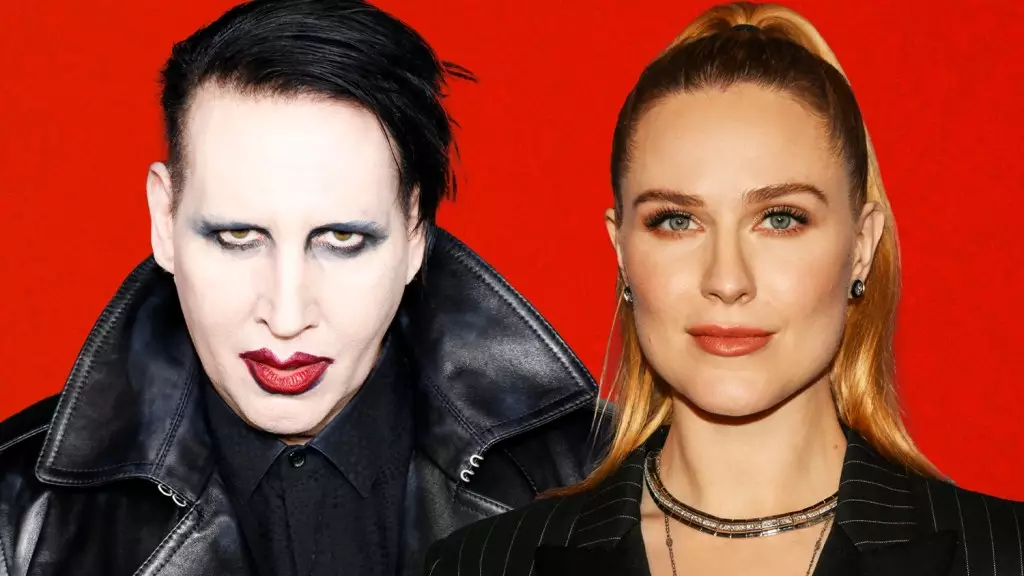The recent Channel 4 documentary series titled “Marilyn Manson: Unmasked” has thrust the complexities of celebrity and trauma into the public eye, particularly through Evan Rachel Wood’s harrowing recollections about her time with the controversial rock musician. The documentary not only serves as a platform for Wood to share her experiences but also acts as a catalyst for discussions concerning consent, power dynamics, and the often troubling intersections of art and personal safety. In an era where testimonies from alleged survivors are increasingly crucial in challenging narratives surrounding abuse, this series could be seen as both a moment of reckoning and a testament to the ongoing struggles faced by many.
In a bold move, Wood divulges her emotional state during the filming of the music video for “Heart-Shaped Glasses,” revealing feelings of violation and a profound sense of surrealism as the events unfolded. She describes a situation where the boundaries of consent blurred, claiming that what was presented to her as a creative endeavor morphed into something much darker. “The way it was pitched to me was that there was going to be a sex scene…where whatever you see would sort of be a blur,” Wood recounted, illustrating how manipulative narratives can dangerously cloak abusive behavior under the guise of artistic expression.
The crux of her account highlights not only her personal trauma but also the broader issue of how women – especially in the entertainment industry – confront variations of predatory behavior masked as consensual actions. The sudden escalation of aggression she describes serves as a distressing reminder of the power disparity that often exists in such scenarios, particularly when one party holds significant sway in a professionally hierarchical context.
Howard King, legal counsel for Marilyn Manson, has responded vehemently to Wood’s allegations, emphasizing a lack of corroborative evidence and attempting to discredit her narrative. The rebuttal that there were witnesses present during the purported incident raises critical questions about the nature of consent and the accountability of bystanders. King’s insistence that Manson was clothed during the filming hints at a common defense mechanism in cases of assault: minimizing the behaviors and discrediting the accuser.
It is important to consider how narratives of victimization are often met with skepticism, thereby perpetuating a culture where survivors may hesitate to speak out. The absence of witnesses does not negate the personal truth of the experience. Wood’s emotional recounting resonates with many who have similarly faced the daunting task of articulating their trauma against the overwhelming tide of disbelief.
Wood’s revelations have stirred a flurry of responses not just from fans and advocates, but also from others who claim to have experienced similar mistreatment at the hands of Manson. These responses echo the need for dialogue that acknowledges the complexities of power, consent, and victimization, especially in a celebrity context where public persona often masks private realities. As Wood herself has suggested, naming the perpetrator is a central component of reclaiming one’s narrative, an act that not only serves personal healing but also aims to inspire solidarity among other survivors.
In the wake of Wood’s allegations, Manson’s journey through the legal system has only intensified. He has faced a barrage of suits and accusations, culminating in his decision to withdraw from a long-standing defamation lawsuit against Wood, further complicating his public image. While Manson insists that his relationships have always been consensual, he must navigate the increasingly complicated waters of accountability that shed light on systemic issues within the music industry.
“Marilyn Manson: Unmasked” represents an important chapter in the ongoing discourse around sexual abuse, consent, and the power dynamics that pervade our culture. Wood’s brave decision to share her experiences encourages a reexamination of not only personal narratives but also the broader implications of celebrity culture and the responsibilities that accompany it. As the documentary continues to unfold, it becomes apparent that these conversations are more than just reflections of individual stories; they are stepping stones toward a larger movement aimed at justice, healing, and ultimately, transformation in societal attitudes towards trauma and abuse.
